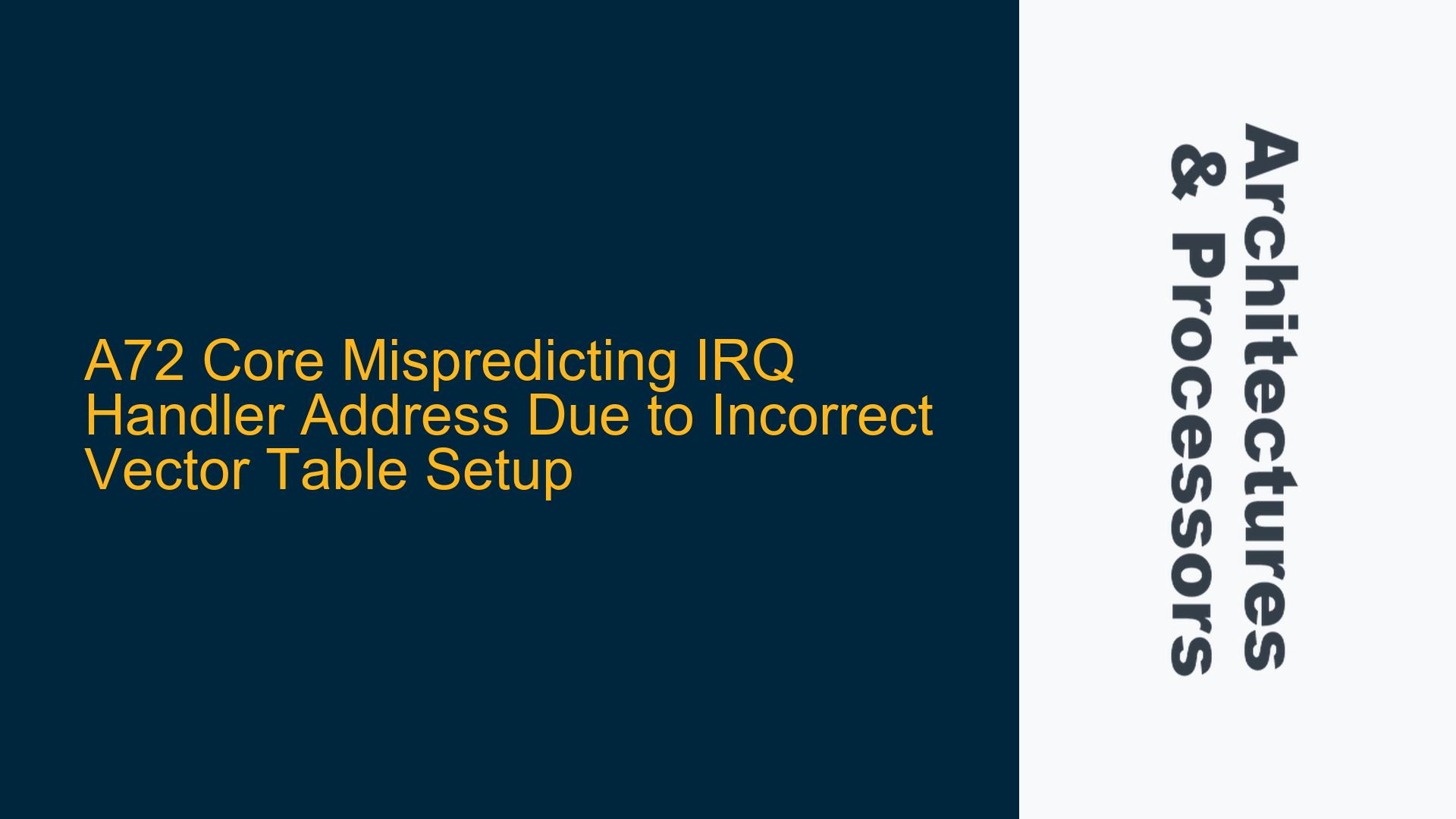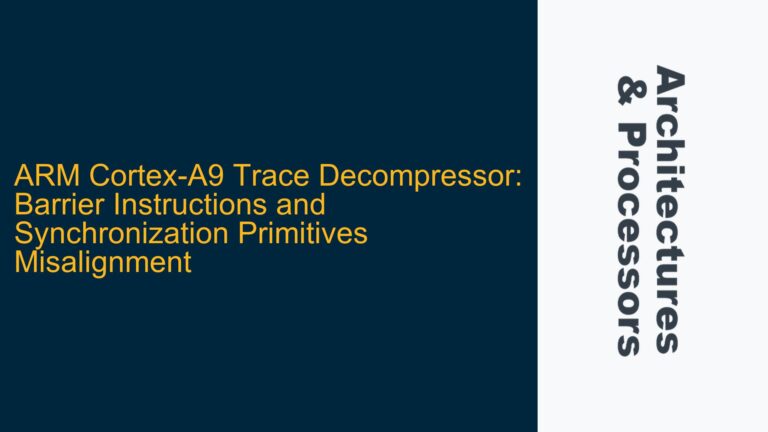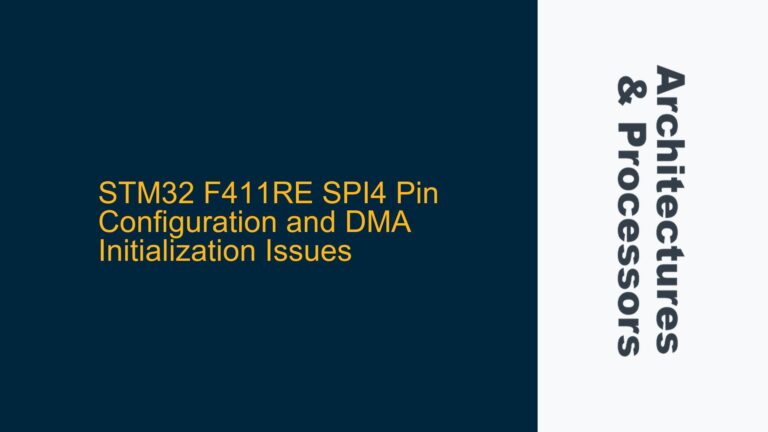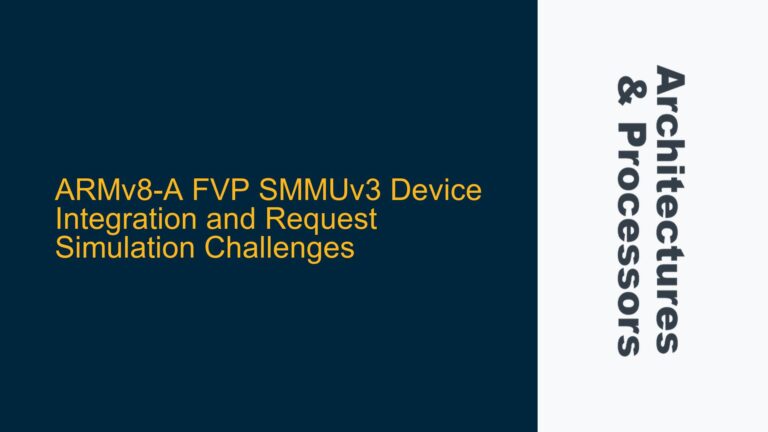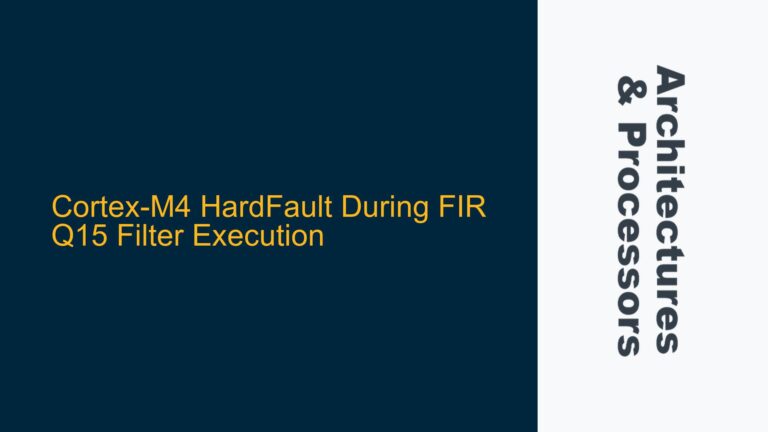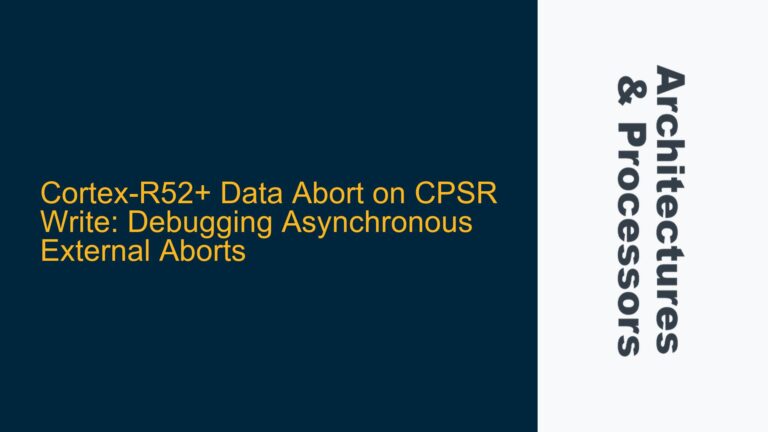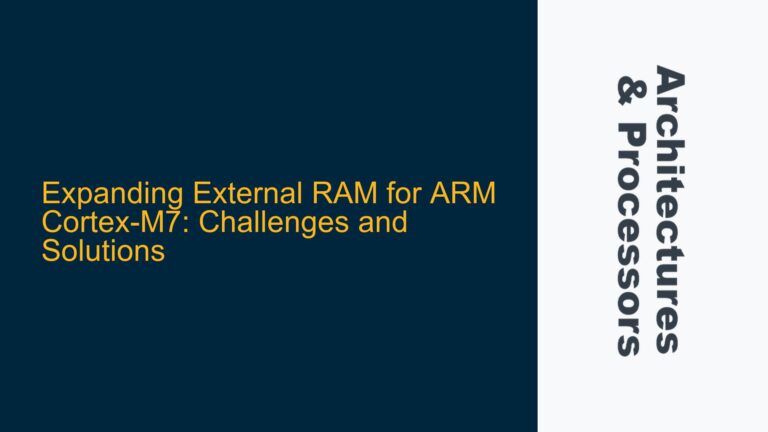ARM Cortex-A72 Incorrectly Interpreting IRQ Handler Opcode as Address
The issue revolves around the ARM Cortex-A72 core incorrectly interpreting the opcode of the IRQ handler as an address during an interrupt request (IRQ) event. When an IRQ is triggered, the core branches to the default IRQ vector address at 0x18 (with V=0 and VE=0). The instruction at this address is intended to load the program counter (PC) with the address of the IRQ handler located at 0xD0. However, instead of executing the instruction at 0xD0, the Cortex-A72 core treats the opcode of the instruction at 0xD0 (e3a00501) as an address and attempts to fetch instructions from this invalid address (e3a00500). This results in a memory abort because the address e3a00500 does not contain valid instructions.
The provided assembly code snippet shows the following:
- At address 0x18:
ldr pc, [pc, #176]loads the PC with the value at address 0xD0. - At address 0xD0:
mov r0, #4194304is the first instruction of the IRQ handler. - The Cortex-A72 core incorrectly fetches from address e3a00500 instead of executing the
movinstruction.
This behavior indicates a fundamental misunderstanding or misconfiguration of the vector table and the IRQ handler setup. The Cortex-A72 core is not correctly interpreting the instructions due to either a misaligned vector table, incorrect memory mappings, or improper handling of the program counter during the IRQ event.
Misaligned Vector Table and Incorrect Program Counter Handling
The root cause of this issue lies in the misalignment or misconfiguration of the vector table and the handling of the program counter during the IRQ event. The Cortex-A72 core expects the vector table to be properly aligned and the instructions at the vector addresses to be valid and executable. However, in this case, the core is misinterpreting the opcode of the IRQ handler as an address, which suggests that the program counter is not being updated correctly or the memory mappings are not properly configured.
One possible cause is that the vector table is not aligned to the expected boundary. The ARM architecture requires the vector table to be aligned to a specific boundary (typically 32 bytes for ARMv8-A). If the vector table is not aligned correctly, the core may misinterpret the instructions or addresses, leading to undefined behavior.
Another possible cause is the incorrect handling of the program counter during the IRQ event. The instruction ldr pc, [pc, #176] at address 0x18 is intended to load the PC with the address of the IRQ handler. However, if the offset calculation is incorrect or the memory address being loaded is invalid, the core may fetch incorrect instructions or treat the opcode as an address.
Additionally, the memory mappings for the vector table and the IRQ handler may not be properly configured. If the memory region containing the vector table and the IRQ handler is not marked as executable or is mapped incorrectly, the core may not be able to fetch and execute the instructions correctly.
Correcting Vector Table Alignment and Ensuring Proper Program Counter Handling
To resolve this issue, the following steps should be taken to ensure proper alignment of the vector table, correct handling of the program counter, and accurate memory mappings:
-
Verify Vector Table Alignment: Ensure that the vector table is aligned to the required boundary. For ARMv8-A, the vector table must be aligned to a 32-byte boundary. This can be achieved by placing the vector table at an address that is a multiple of 32. For example, if the vector table is located at address 0x0, it should be aligned to 0x0, 0x20, 0x40, etc.
-
Check Program Counter Offset Calculation: Verify that the offset calculation in the
ldr pc, [pc, #176]instruction is correct. The offset should point to the address of the IRQ handler. In this case, the offset of 176 should correctly point to address 0xD0. Ensure that the address calculation is accurate and that the memory location at 0xD0 contains the correct IRQ handler instructions. -
Validate Memory Mappings: Ensure that the memory region containing the vector table and the IRQ handler is properly mapped and marked as executable. The memory management unit (MMU) should be configured to map the vector table and the IRQ handler to the correct physical addresses and mark these regions as executable. This can be done by setting the appropriate memory attributes in the MMU page tables.
-
Implement Data Synchronization Barriers: Insert data synchronization barriers (DSB) and instruction synchronization barriers (ISB) to ensure that the core has a consistent view of memory and that the instructions are fetched and executed in the correct order. A DSB should be placed after writing to the vector table or updating the program counter, and an ISB should be placed before executing the IRQ handler.
-
Debugging with Trace and Debug Tools: Use ARM CoreSight or other debugging tools to trace the execution flow and verify that the core is correctly fetching and executing the instructions from the vector table and the IRQ handler. This can help identify any discrepancies in the instruction fetch or execution process.
-
Review Exception Handling Configuration: Ensure that the exception handling configuration is correctly set up. This includes verifying the values of the Vector Base Address Register (VBAR) and the Exception Level (EL) at which the IRQ is being handled. The VBAR should point to the base address of the vector table, and the EL should be set correctly based on the system design.
-
Check for Compiler or Assembler Issues: Verify that the compiler or assembler is generating the correct opcodes for the instructions in the vector table and the IRQ handler. Sometimes, compiler or assembler bugs can result in incorrect opcodes being generated, leading to unexpected behavior.
By following these steps, the issue of the Cortex-A72 core misinterpreting the IRQ handler opcode as an address can be resolved. Proper alignment of the vector table, accurate handling of the program counter, and correct memory mappings are critical to ensuring that the core correctly fetches and executes the IRQ handler instructions. Additionally, using debugging tools and reviewing the exception handling configuration can help identify and resolve any underlying issues.
Detailed Explanation of Key Concepts
Vector Table Alignment
The vector table is a critical component of the ARM architecture that contains the addresses of exception handlers, including the IRQ handler. The ARM architecture requires the vector table to be aligned to a specific boundary to ensure that the core can correctly fetch and execute the exception handlers. For ARMv8-A, the vector table must be aligned to a 32-byte boundary. This means that the base address of the vector table must be a multiple of 32.
If the vector table is not aligned correctly, the core may misinterpret the instructions or addresses, leading to undefined behavior. For example, if the vector table is misaligned, the core may fetch incorrect instructions or treat the opcode of an instruction as an address, as seen in the issue described.
Program Counter Handling
The program counter (PC) is a register that holds the address of the next instruction to be executed. During an IRQ event, the core branches to the IRQ vector address and executes the instruction at that address. In this case, the instruction at address 0x18 is ldr pc, [pc, #176], which loads the PC with the address of the IRQ handler.
The offset calculation in the ldr instruction is critical to ensuring that the correct address is loaded into the PC. The offset should point to the address of the IRQ handler. In this case, the offset of 176 should correctly point to address 0xD0. If the offset calculation is incorrect, the core may load an incorrect address into the PC, leading to undefined behavior.
Memory Mappings
The memory management unit (MMU) is responsible for mapping virtual addresses to physical addresses and setting memory attributes such as executability, readability, and writability. The memory region containing the vector table and the IRQ handler must be properly mapped and marked as executable to ensure that the core can fetch and execute the instructions.
If the memory region is not marked as executable, the core will not be able to fetch and execute the instructions, leading to a memory abort. Additionally, if the memory region is mapped incorrectly, the core may fetch incorrect instructions or treat the opcode of an instruction as an address.
Data Synchronization Barriers
Data synchronization barriers (DSB) and instruction synchronization barriers (ISB) are used to ensure that the core has a consistent view of memory and that the instructions are fetched and executed in the correct order. A DSB ensures that all memory accesses before the barrier are completed before any memory accesses after the barrier are executed. An ISB ensures that all instructions before the barrier are completed before any instructions after the barrier are executed.
In the context of exception handling, a DSB should be placed after writing to the vector table or updating the program counter to ensure that the core has a consistent view of memory. An ISB should be placed before executing the IRQ handler to ensure that the core fetches and executes the correct instructions.
Debugging with Trace and Debug Tools
ARM CoreSight and other debugging tools can be used to trace the execution flow and verify that the core is correctly fetching and executing the instructions from the vector table and the IRQ handler. These tools can provide detailed information about the instruction fetch, execution, and memory access patterns, helping to identify any discrepancies in the process.
By using these tools, developers can gain insight into the behavior of the core and identify any issues with the vector table, program counter handling, or memory mappings. This can help to quickly diagnose and resolve issues related to exception handling and IRQ processing.
Exception Handling Configuration
The exception handling configuration includes the Vector Base Address Register (VBAR) and the Exception Level (EL) at which the IRQ is being handled. The VBAR holds the base address of the vector table, and the EL determines the privilege level at which the exception is handled.
The VBAR should be set to the base address of the vector table to ensure that the core can correctly fetch the exception handlers. The EL should be set correctly based on the system design to ensure that the IRQ is handled at the appropriate privilege level.
If the VBAR is not set correctly, the core may fetch incorrect exception handlers or treat the opcode of an instruction as an address. Similarly, if the EL is not set correctly, the core may not handle the IRQ at the appropriate privilege level, leading to undefined behavior.
Compiler and Assembler Issues
Compiler or assembler bugs can result in incorrect opcodes being generated for the instructions in the vector table and the IRQ handler. This can lead to unexpected behavior, such as the core misinterpreting the opcode of an instruction as an address.
To avoid this issue, developers should verify that the compiler or assembler is generating the correct opcodes for the instructions. This can be done by disassembling the generated binary and comparing the opcodes with the expected values.
Summary
The issue of the ARM Cortex-A72 core misinterpreting the IRQ handler opcode as an address is caused by a combination of misaligned vector table, incorrect program counter handling, and improper memory mappings. By ensuring proper alignment of the vector table, accurate handling of the program counter, and correct memory mappings, this issue can be resolved. Additionally, using debugging tools and reviewing the exception handling configuration can help identify and resolve any underlying issues. Proper use of data synchronization barriers and verification of compiler or assembler output are also critical to ensuring correct behavior.
